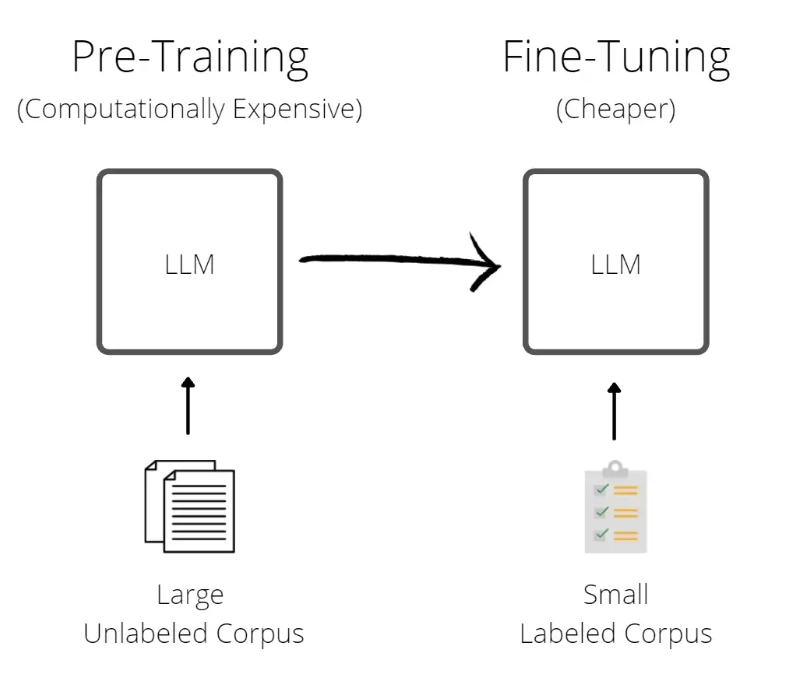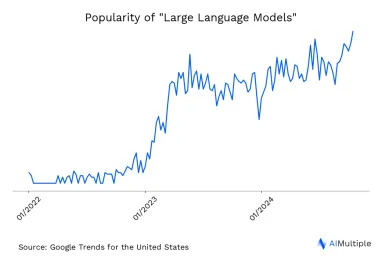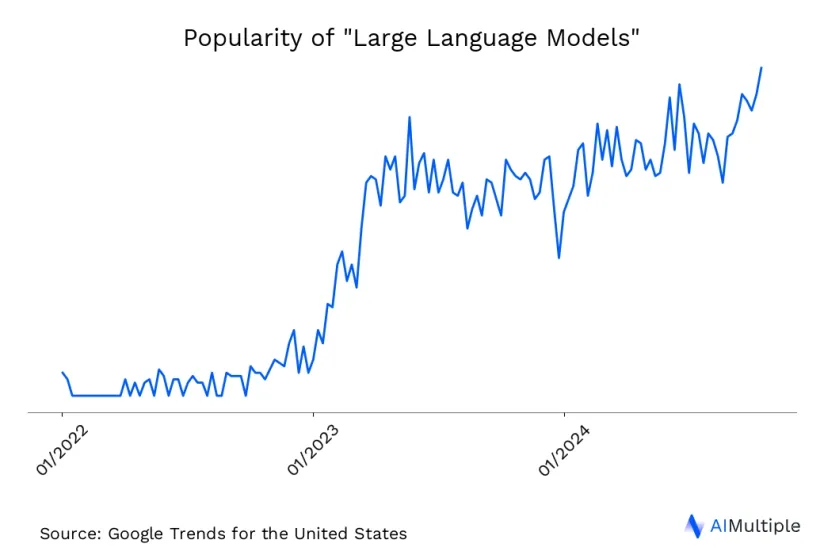Large language models (LLMs) have generated much hype in recent months (see Figure 1). The demand has led to the ongoing development of websites and solutions that leverage language models. ChatGPT set the record for the fastest-growing user base in January 2023, proving that language models are here to stay. This is also shown by the fact that Bard, Google’s answer to ChatGPT, was introduced in February 2023.
Language models are also opening new possibilities for businesses, as they can:
- Automate processes
- Save time and money
- Drive personalization
- Increase accuracy in tasks
Yet, large language models are a new development in computer science. Because of this, business leaders may not be up-to-date on such models. We wrote this article to inform curious business leaders in large language models:
- Definition
- Examples
- Use cases
- Training
- Benefits
- Challenges
If you are building your own LLM, here is a guide to gathering LLM data collection.
What is a large language model?

Figure 2: Foundational model, Source: ArXiv
Large language models (LLMs) are foundation models that utilize deep learning in natural language processing (NLP) and natural language generation (NLG) tasks. For the purpose of helping them learn the complexity and linkages of language, large language models are pre-trained on a vast amount of data. Using techniques such as:
- Fine-tuning
- In-context learning
- Zero-/one-/few-shot learning
these models can be adapted for downstream (specific) tasks (see Figure 2).
An LLM is essentially a Transformer-based neural network, introduced in an article by Google engineers titled “Attention is All You Need” in 2017.1 The goal of the model is to predict the text that is likely to come next. The sophistication and performance of a model can be judged by how many parameters it has. A model’s parameters are the number of factors it considers when generating output.
Large language model examples
There are many open-source language models that are deployable on-premise or in a private cloud, which translates to fast business adoption and robust cybersecurity. Some large language models in this category are:
- BLOOM
- NeMO LLM
- XLM-RoBERTa
- XLNet
- Cohere
- GLM-130B
Most of the leading language model developers are based in the US, but there are successful examples from China and Europe as they work to catch up on generative AI.
You can check our article on large language model examples for more information.
What are the use cases of language models?
Large language models can be applied to a variety of use cases and industries, including healthcare, retail, tech, and more. The following are use cases that exist in all industries:
- Text summarization
- Text generation
- Sentiment analysis
- Content creation
- Chatbots, virtual assistants, and conversational AI
- Named entity recognition
- Speech recognition and synthesis
- Image annotation
- Text-to-speech synthesis
- Spell correction
- Machine translation
- Recommendation systems
- Fraud detection
- Code generation
How large language models are trained
Large language models are deep learning neural networks, a subset of artificial intelligence and machine learning. Large language models are first pre-trained so that they learn basic language tasks and functions. Pretraining is the step that requires massive computational power and cutting-edge hardware.

Once the model is pre-trained, it can be trained with task-specific new data to fine-tune it for specific use cases. The fine-tuning method has high computational efficiency since it requires less data and power, making it a cheaper method (see Figure 3).
For more information, check our “Large Language Model Training in 2024” article.
4 benefits of large language models
1- Reduce manual labor and costs
Language models can be used to automate many processes, such as:
- Sentiment analysis
- Customer service
- Content creation
- Fraud detection
- Prediction and classification
Automating such tasks leads to reduced manual labor and related costs.
2- Enhance availability, personalization, and customer satisfaction
Many customers expect businesses to be available 24/7, which is achievable through chatbots and virtual assistants that utilize language models. With automated content creation, language models can drive personalization by processing large amounts of data to understand customer behavior and preferences. Customer satisfaction and positive brand relations will increase with availability and personalized service.
3- Save time
Language model systems can automate many processes in marketing, sales, HR, and customer service. For example, language models can help with data entry, customer service, and document creation, freeing up employees to work on more important tasks that require human expertise.
Another area where language models can save time for businesses is in the analysis of large amounts of data. With the ability to process vast amounts of information, businesses can quickly extract insights from complex datasets and make informed decisions. This can lead to improved operational efficiency, faster problem-solving, and better-informed business decisions.
Increase accuracy in tasks
Large language models are capable of processing vast amounts of data, which leads to improved accuracy in prediction and classification tasks. The models use this information to learn patterns and relationships, which helps them make better predictions and groupings.
For example, in sentiment analysis, a large language model can analyze thousands of customer reviews to understand the sentiment behind each one, leading to improved accuracy in determining whether a customer review is positive, negative, or neutral. This improved accuracy is critical in many business applications, as small errors can have a significant impact.
Challenges and limitations of language models
1- Reliability and bias
Language models’ capabilities are limited to the textual training data they are trained with, which means they are limited in their knowledge of the world. The models learn the relationships within the training data, and these may include:
- False information
- Race, gender, and sex bias
- Toxic language
When training data isn’t examined and labeled, language models have been shown to make racist or sexist comments.
There are also instances where models can present false information.
2- Context window
Each large language model only has a certain amount of memory, so it can only accept a certain number of tokens as input. For instance, ChatGPT has a limit of 2048 tokens (around 1,500 words), which means ChatGPT can’t make sense of inputs and generate outputs for inputs exceeding the 2048 token limit.
3- System costs
Developing large language models requires significant investment in the form of computer systems, human capital (engineers, researchers, scientists, etc.), and power. Being resource intensive makes the development of large language models only available to huge enterprises with vast resources. It is estimated that Megatron-Turing from NVIDIA and Microsoft, has a total project cost of close to $100 million.3
4- Environmental impact
Megatron-Turing was developed with hundreds of NVIDIA DGX A100 multi-GPU servers, each using up to 6.5 kilowatts of power. Along with a lot of power to cool this huge framework, these models need a lot of power and leave behind large carbon footprints.
According to a study, training BERT (LLM by Google) on GPU is roughly equivalent to a trans-American flight.4
If you want to learn more about large language models, don’t hesitate to contact us:
This article was drafted by former AIMultiple industry analyst Berke Can Agagündüz.



Comments
Your email address will not be published. All fields are required.